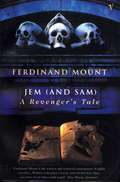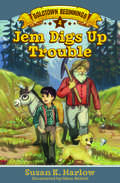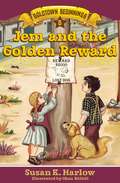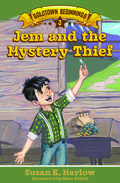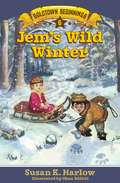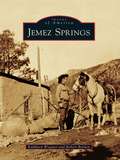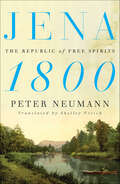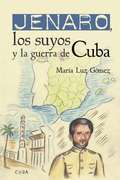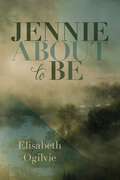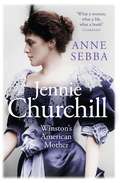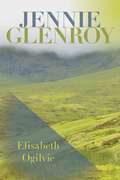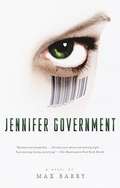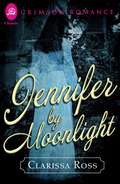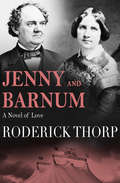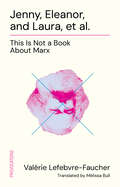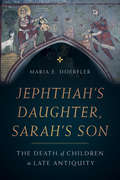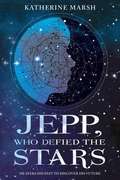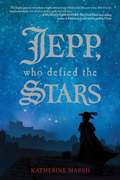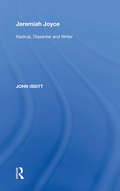- Table View
- List View
Jem (and Sam)
by Ferdinand MountHow does Jeremiah Mount, the dealer in pornography, come to be the lover of the Duchess of Albemarle and the colleague of the great Samuel Pepys? In Pepys' Diary, Jem Mount plays a shadowy role, but in Jem's own memories Sam looms large. Friends and drinking partners at first, they become vicious rivals for fame and women. In his struggle to survive and triumph over his adversary in a rackety world, Jemm stumbles into many trades: chemist, butler, soldier, secretary and, now and then, lover.This 'newly discovered autobiography' - with its disconcerting echoes of our own time - takes its dubious hero from the shaky days of Cromwellian England, through the unbuttoned license of the Restoration, to the panic of Monmouth's Rebellion and the Jamaica sugar boom.
Jem Digs Up Trouble (Goldtown Beginnings #4)
by Susan K. MarlowJem is turning eight years old. And there's just one thing he wants for his birthday: a prospecting trip with Strike-it-rich Sam. With his grown-up friend to watch out for him, Jem's parents say yes. It's off for two weeks in the mountains to find gold!But this trip isn't going as planned. There are more tall tales from Sam than there are deep pockets of gold ore. And the map to rich diggings they brought along doesn't have any treasure at the end of it. Striking it rich is a lot harder than it looks.When they find an unexpected cache, things seem to be looking up. But Jem and Sam shouldn't count their gold nuggets before they get home. An injury, a bad detour, and other problems plague them. Not only are they empty-handed, they might never make it home at all!
Jem and the Golden Reward (Goldtown Beginnings #5)
by Susan K. MarlowNo one really knows where Jem’s beloved dog, Nugget, came from when Strike-it-rich Sam found him. Jem doesn’t care; he just knows he loves his pup. But now "missing dog" posters are going up around town--and the dog looks just like Nugget!It turns out the pooch is a golden retriever, a brand-new breed that’s very rare. A rich man from Scotland was visiting San Francisco when one of his dogs was lost in the mountains above Goldtown. There’s a reward for the dog’s return--and mean Will Sterling wants the money.Jem is desperate to keep his furry best friend, and he’s sure Nugget wants to stay with him too. But when he tries to hide out in the woods, he has no idea of the danger that awaits them. . . .
Jem and the Mystery Thief (Goldtown Beginnings #3)
by Susan K. MarlowJem can't wait for school to let out for the year. Is there anything more boring than class when you could be outside? When rich boy Will brings a coin collection to school, it's an exciting treat. It isn't often the students get to see all that interesting money in one place.Then a silver dollar goes missing during recess--and Jem is blamed! After all, he's the only one who went indoors on this sunny day. When a charm bracelet is stolen the next day, more fingers point his way.Jem knows he isn't the culprit. But how can he prove it? To clear his name, Jem sets a trap for the mystery thief--his sister's gold locket lays in plain sight on his desk as bait. Will it go missing too? Or will Jem's good name be muddied forever?
Jem's Wild Winter (Goldtown Beginnings #6)
by Susan K. MarlowThere’s never been a winter like this in all of Jem Coulter's eight years. After weeks of heavy snowfall, no one can pan for gold. And all the wild critters from rabbits to cougars are coming down to the low country around Goldtown looking for food to stay alive. It isn't all bad, though--animals mean Pa can put out a trapline to make some money for the family. Jem is excited to help with this grownup job, until their overnight campsite in the wintery woods has an unexpected visitor. Now they're in the most danger Jem's ever faced!
Jemez Springs
by Robert Borden Kathleen WiegnerIn 1849, James Hervy Simpson, a lieutenant and engineer in the Army Corps of Topographical Engineers, was ordered to survey a wagon road as a southern alternative to the Santa Fe Trail from Fort Smith, Arkansas, to Santa Fe, New Mexico. Simpson hired two brothers, Edward "Ned" and Richard Kern, to provide survey sketches that included the pueblo ruins of Giusewa and natural hot springs of Ojo Caliente, which are known today as Jemez Springs. Prior to incorporation in 1955, Jemez Springs, like many frontier towns, was supported by ranching, logging, and mining. It also had an influx of tourists who enjoyed the hot springs or one of the many dude ranches in the area. In 1995, Jemez Springs won an award as an All-America City from the National Civic League, and with a mere 375 residents at the time, it was one of the smallest communities to earn the honor.
Jena 1800: The Republic of Free Spirits
by Peter Neumann“An exhilarating account of a remarkable historical moment, in which characters known to many of us as immutable icons are rendered as vital, passionate, fallible beings . . . Lively, precise, and accessible.”—Claire Messud, Harper’sAround the turn of the nineteenth century, a steady stream of young German poets and thinkers coursed to the town of Jena to make history. The French Revolution and the Napoleonic Wars had dealt a one-two punch to the dynastic system. Confidence in traditional social, political, and religious norms had been replaced by a profound uncertainty that was as terrifying for some as it was exhilarating for others. Nowhere was the excitement more palpable than among the extraordinary group of poets, philosophers, translators, and socialites who gathered in this Thuringian village of just four thousand residents.Jena became the place for the young and intellectually curious, the site of a new departure, of philosophical disruption. Influenced by Johann Wolfgang von Goethe, then an elder statesman and artistic eminence, the leading figures among the disruptors—the translator August Wilhelm Schlegel; the philosophers Friedrich "Fritz" Schlegel and Friedrich Schelling; the dazzling, controversial intellectual Caroline Schlegel, married to August; Dorothea Schlegel, a poet and translator, married to Fritz; and the poets Ludwig Tieck and Novalis—resolved to rethink the world, to establish a republic of free spirits. They didn’t just question inherited societal traditions; with their provocative views of the individual and of nature, they revolutionized our understanding of freedom and reality.With wit and elegance, Peter Neumann brings this remarkable circle of friends and rivals to life in Jena 1800, a work of intellectual history that is colorful and passionate, informative and intimate—as fresh and full of surprises as its subjects.
Jena to Eylau: The Disgrace and the Redemption of the Old-Prussian Army
by C. F. Atkinson Field Marshal Freiherr Colmar Von der GoltzThis ebook is purpose built and is proof-read and re-type set from the original to provide an outstanding experience of reflowing text for an ebook reader. Field-Marshal Von der Goltz was one of the most widely read military authors of the late 19th century; his ideas and theories of the "Nation in Arms" were to be brought into practice during the First World War, during which he served. His wide military experience ranged from the practical during the 1866 Bohemian campaign to the Franco-Prussian war of 1870-71, before moving on to staff and teaching posts. He authored many works during his time as part of the historical section of the Prussian General Staff, mostly about the theory of war and the victorious campaigns of the 1870-71. A fiercely patriotic man, he was inspired to write about the great defeat of the Prussian army of 1806 as part history and part catharsis. His work is supremely detailed and his great critical military mind avoids bias in favour of the Prussians. This title is acclaimed as a military classic along with his "Von Rossbach bis Jena und Auerstädt" and "Nation in Arms". Title - Jena to Eylau Sub-Title - The Disgrace and the Redemption of the Old-Prussian Army Author -- Field Marshal Freiherr Colmar Von der Goltz (1843-1916) Translator -- C. F. Atkinson (????-????) Text taken, whole and complete, from the edition published in 1913, London, by Kegan Paul, Trench, Trübner & Co. Ltd. Original - xv and 340 pages. Illustrations - The maps cannot be reproduced with this volume as they are A3.
Jenaro, los suyos y la guerra de Cuba
by María Luz GómezBiografía histórica en la trepidante época de la España del siglo XIX. Libro familiar e histórico. Trata de un militar que luchó en la guerra de Cuba, y en la Revolución «Gloriosa» española, y de su entorno familiar. <P><P>Relata la vida de Jenaro Roldán del nacimiento a la muerte, con los avatares nacionales de su época, históricos y familiares. Y se completa con algunas noticias de los suyos tras su fallecimiento.
Jennie About to Be
by Elisabeth OgilvieIn 1809, marriage was the best a spirited, healthy, and intelligent girl could hope for, especially if she was an orphan without a fortune. Jennie Hawthorne has been hustled to London by her well-meaning aunt to secure just such a marriage, though Jennie despises the prospective wife parade and yearns for her childhood home by the North Sea. All that changes when she falls for the dashing soldier Nigel Gilchrist, marrying him after a whirlwind romance. Nigel wastes no time whisking his bride to the Scottish Highlands where he will serve as manager to the family estate.In Scotland Jennie is faced with the realities of the Highland Clearances: tenant cottagers forcibly evicted from their homes by lairds to make way for sheep and grazing land. When Jennie learns that both Nigel and his brother are complicit in such clearances, she finds her heart warring with her conscience. She defies Nigel and his brother, doing what she can to help the cottagers, and helping Alick Gilchrist resist the clearances. But their efforts bring disaster: a tragic accident makes Alick a hunted fugitive, and Jennie is compelled by circumstance to throw her lot in with his as they face an arduous journey across mountains to ultimately escape the strife-ridden Highlands.
Jennie Churchill: Winston's American Mother
by Anne SebbaJennie Churchill was said to have had two hundred lovers, three of whom she married. But her love for her son Winston never wavered. Jennie Churchill is an intimate picture of her glittering but ultimately tragic life, and the powerful mutual infatuation between her and her son. Anyone who wants to understand Winston must start here, with this revelatory interpretation. Anne Sebba has gained unprecedented access to private family correspondence, newly discovered archival material and interviews with Jennie's two surviving granddaughters. She draws a vivid and frank portrait of her subject, repositioning Jennie as a woman who refused to be cowed by her era's customary repression of women.
Jennie Glenroy
by Elisabeth OgilvieJennie and Alick Glenroy arrived in Maine with nothing, not even their names, starting anew in a different land, leaving the turmoil and violence of Scotland behind them. Almost twenty years later, the "Godless Glenroys" are a prosperous, though sometimes controversial, family. Alick is the proprietor of a successful shipyard, and Jennie has raised their five children to think for themselves, a trait that occasionally raises the ire of their staid neighbors.The Glenroys, along with the other inhabitants of Whittier, find themselves facing issues that they've long been sheltered from: slavery, malice, and violence. Jennie and Alick must defend their children against malicious accusations and guide them through the trials of adolescence, but also allow them the independence and space to grow into intelligent and principled adults. When a figure from their fugitive past sails into town, everything they have worked to build over the past twenty years is in danger of being torn asunder, but all they can do is face these new challenges with the same courage and persevering spirit that carried them over Highland mountains so many years before.
Jennie Lee, Patriot
by Anne EmeryThis is antebellum Charleston, ante-Revolutionary bellum that is, and it is surprising how closely the situation and the scaffold of the story parallel those of the Civil War. Jennie Lee Lawrence is a plantation owner's daughter when the war reaches Charleston in 1780. The war destroys families and friendships and when the city is occupied, Jennie makes a daring midnight ride to warn her sweetheart who is a Patriot spy. He is also the son of her overseer, an alliance which would not have been possible before the war. On the other hand Jennie's sister marries a Loyalist boy who would previously have been acceptable to the family but now is not. With minor exceptions, the historical progress of the war is rather nebulous; Jennie Lee endures very little; but her story does present a conception of the strain on human relations which such a war brings.
Jennie: The Romantic Years 1854-1895
by Ralph G. MartinHaving spent 30 weeks on the New York Times bestseller list, Ralph Martin's Jennie: The Life of Lady Randolph Churchill is the story of a girl from Brooklyn who became the toast of British society.
Jennifer Government
by Max BarryTaxation has been abolished, the government has been privatized, and employees take the surname of the company they work for. It's a brave new corporate world, but you don't want to be caught without a platinum credit card--as lowly Merchandising Officer Hack Nike is about to find out. Trapped into building street cred for a new line of $2500 sneakers by shooting customers, Hack attracts the barcode-tattooed eye of the legendary Jennifer Government. A stressed-out single mom, corporate watchdog, and government agent who has to rustle up funding before she's allowed to fight crime, Jennifer Government is holding a closing down sale--and everything must go. A wickedly satirical and outrageous thriller about globalization and marketing hype, Jennifer Government is the best novel in the world ever.From the Trade Paperback edition.
Jennifer Government: A Novel
by Max BarryIn the future, the world will be run by giant American corporations, Everybody will be so happy, tax-free and rich that they will change their name to that of their company. Hack Nike, however, is a lowly Merchandising Officer with negative career equity. In the future, this is not a good thing. So when John Nike and John Nike offer Hack Nike a job marketing a new line of really, really expensive trainers he is understandably thrilled. He is less thrilled when he discovers that his duties include shooting teenagers.
Jennifer by Moonlight
by Clarissa RossAs Crimson Romance celebrates its first anniversary, we honor those pioneers who helped shape the direction of romance novels for all of us. Suspense, mystery, paranormal activity and love - always love - have been the cornerstone of the genre since the early 1970s. Now we have updated the covers to these classics - but not the words - and reissued these timeless reads to let you relive the thrill of discovering a world of romance all over again.Lucy Dorset came to Moorgate as the happy bride of a dedicated young doctor. But she soon discovered that the old stone house was inhabited by a pale and lovely ghost, a victim of a fatal romantic triangle long ago. Was she imagining her husband's sudden jealous moods? And a rival for his affections in sultry Sheila Farley? Lucy feared that the unhappy spirits of Moorgate were pushing her toward a reenactment of a violent, century-old tragedy. She realized that she alone must rid the house of the menacing presence that threatened her marriage.Sensuality Level: Behind Closed Doors
Jennifer by Moonlight
by Clarissa RossAs Crimson Romance celebrates its first anniversary, we honor those pioneers who helped shape the direction of romance novels for all of us. Suspense, mystery, paranormal activity and love - always love - have been the cornerstone of the genre since the early 1970s. Now we have updated the covers to these classics - but not the words - and reissued these timeless reads to let you relive the thrill of discovering a world of romance all over again.Lucy Dorset came to Moorgate as the happy bride of a dedicated young doctor. But she soon discovered that the old stone house was inhabited by a pale and lovely ghost, a victim of a fatal romantic triangle long ago. Was she imagining her husband’s sudden jealous moods? And a rival for his affections in sultry Sheila Farley? Lucy feared that the unhappy spirits of Moorgate were pushing her toward a reenactment of a violent, century-old tragedy. She realized that she alone must rid the house of the menacing presence that threatened her marriage.Sensuality Level: Behind Closed Doors
Jennifer by Moonlight
by Clarissa RossAs Crimson Romance celebrates its first anniversary, we honor those pioneers who helped shape the direction of romance novels for all of us. Suspense, mystery, paranormal activity and love - always love - have been the cornerstone of the genre since the early 1970s. Now we have updated the covers to these classics - but not the words - and reissued these timeless reads to let you relive the thrill of discovering a world of romance all over again.Lucy Dorset came to Moorgate as the happy bride of a dedicated young doctor. But she soon discovered that the old stone house was inhabited by a pale and lovely ghost, a victim of a fatal romantic triangle long ago. Was she imagining her husband’s sudden jealous moods? And a rival for his affections in sultry Sheila Farley? Lucy feared that the unhappy spirits of Moorgate were pushing her toward a reenactment of a violent, century-old tragedy. She realized that she alone must rid the house of the menacing presence that threatened her marriage.Sensuality Level: Behind Closed Doors
Jenny and Barnum: A Novel of Love
by Roderick ThorpA diva and a showman work together to make history, finding romance along the way After Queen Victoria, Jenny Lind is the most famous woman in Europe. A Swedish soprano with a voice like an angel&’s and a temperament to match, she is in Vienna when she meets the shortest man she has ever seen. General Tom Thumb is a three-foot-tall sensation whom P. T. Barnum has made one of the wealthiest men in the world. Thumb arrives with a message from Barnum offering Lind more money than she has ever dreamed of, to do something she has never done before: perform in America. While Lind makes her way across the Atlantic, Barnum, the Great American Showman, whips US audiences into a frenzy. By the time the singer lands in New York, &“Lindomania&” is in full effect. As Lind and Barnum travel the country, they play for packed houses every night. The public loves Lind, but as the tour wears on, P. T. Barnum will come to love her more.
Jenny, Eleanor, and Laura, et al.: This Is Not a Book About Marx
by Valérie Lefebvre-FaucherThis is not a book about Karl Marx. Rather, it is an investigation of the women in his life. Valérie Lefebvre-Faucher follows a labyrinth of historical letters, traces the branches on an intellectual family tree, and untangles a web of correspondence, to reveal forgotten connections and to map out the negative spaces in the literature. What emerges is not the familiar portrait of Karl alone in his frame, but a group photo of the whole Marx gang. Upturning the picture we have of the early days of modern communism, Jenny, Eleanor, and Laura, et al. calls on us to acknowledge that humans think and create together, not alone.
Jephthah’s Daughter, Sarah’s Son: The Death of Children in Late Antiquity (Christianity in Late Antiquity #8)
by Maria E. DoerflerLate antiquity was a perilous time for children, who were often the first victims of economic crisis, war, and disease. They had a one in three chance of dying before their first birthday, with as many as half dying before age ten. Christian writers accordingly sought to speak to the experience of bereavement and to provide cultural scripts for parents who had lost a child. These late ancient writers turned to characters like Eve and Sarah, Job and Jephthah as models for grieving and for confronting or submitting to the divine. Jephthah's Daughter, Sarah’s Son traces the stories these writers crafted and the ways in which they shaped the lived experience of familial bereavement in ancient Christianity. A compelling social history that conveys the emotional lives of people in the late ancient world, Jephthah's Daughter, Sarah's Son is a powerful portrait of mourning that extends beyond antiquity to the present day.
Jepp, Who Defied The Stars
by Katherine MarshFate: Is it written in the stars from the moment we are born? Or is it a bendable thing that we can shape with our own hands? Jepp of Astraveld needs to know. He left his countryside home on the empty promise of a stranger, only to become a captive in a luxurious prison: Coudenberg Palace, the royal court of the Spanish Infanta. Nobody warned Jepp that as a court dwarf, daily injustices would become his seemingly unshakable fate. If the humiliations were his alone, perhaps he could endure them; but it breaks Jepp's heart to see his friend Lia suffer. After Jepp and Lia attempt a daring escape from the palace, Jepp is imprisoned again, alone in a cage. Now, spirited across Europe in a kidnapper's carriage, Jepp fears where his unfortunate stars may lead him. But he can't even begin to imagine the brilliant and eccentric new master-a man devoted to uncovering the secrets of the stars-who awaits him. Or the girl who will help him mend his heart and unearth the long-buried secrets of his past. Masterfully written, grippingly paced, and inspired by real historical characters, Jepp, Who Defied the Stars is the tale of an extraordinary hero and his inspiring quest to become the master of his own destiny.
Jepp, Who Defied the Stars
by Katherine MarshFate: Is it written in the stars from the moment we are born? Or is it a bendable thing that we can shape with our own hands? Jepp of Astraveld needs to know. He left his countryside home on the empty promise of a stranger, only to become a captive in a luxurious prison: Coudenberg Palace, the royal court of the Spanish Infanta. Nobody warned Jepp that as a court dwarf, daily injustices would become his seemingly unshakable fate. If the humiliations were his alone, perhaps he could endure them; but it breaks Jepp's heart to see his friend Lia suffer. After Jepp and Lia attempt a daring escape from the palace, Jepp is imprisoned again, alone in a cage. Now, spirited across Europe in a kidnapper's carriage, Jepp fears where his unfortunate stars may lead him. But he can't even begin to imagine the brilliant and eccentric new master-a man devoted to uncovering the secrets of the stars-who awaits him. Or the girl who will help him mend his heart and unearth the long-buried secrets of his past. Masterfully written, grippingly paced, and inspired by real historical characters, Jepp, Who Defied the Stars is the tale of an extraordinary hero and his inspiring quest to become the master of his own destiny. "This highly unusual story about a highly unusual hero will also feel like your story. Few of us are imprisoned dwarfs, but all of us want to guide our own lives." -- Jonathan Safran Foer, New York Times best-selling author of Extremely Loud and Incredibly Close "Rich, absorbing storytelling-a terrific read in every way." -- Nancy Werlin, National Book Award Finalist and author of Impossible "Delightful characters, unique setting, and lovely prose. This is historical fiction at its best!" -- Ruta Sepetys, New York Times best-selling author of Between Shades of GrayNew York Times Notable Children's Books of 2012The Wall Street Journal Best Children's Books of 2012
Jeremiah Joyce: Radical, Dissenter and Writer (Science, Technology, And Culture, 1700-1945 Ser.)
by John IssittJeremiah Joyce was one of the accused in the famous Treason Trials of 1794 which marked the suppression of radical agitation in Britain for the ensuing twenty years. He was a political radical who imbibed the traditions of the 'commonwealthman' and actively campaigned for a more democratic and representative state. Through the early 1790s he acted as the metropolitan political agent for his patron the Earl of Stanhope and he liased between radical groups whilst also distributing radical literature including Tom Paine's Rights of Man. He was one of the very few artisans at the end of the eighteenth century adopted by the literary and scientific intelligentsia and was unique in training to become a Unitarian minister at the age of 23 after serving a seven-year trade apprenticeship and having worked as a journeyman. This work traces the legacies, traditions and visions of the English Enlightenment as they are expressed through Joyce's life and literary production. It explores the evolution of these traditions against the threatening background of the French revolution and the developing imperatives for education in general, and science education in particular. By tracing the linkages between political, educational, scientific and publishing cultures, it reflects on the issues of late eighteenth century patronage, the literary forms of popular science and the evolution of the metropolitan book trade. In so doing the book recovers the life of a hitherto much neglected science writer and political activist and contributes to the histories of politics, education, science and the developing discipline of book history.
